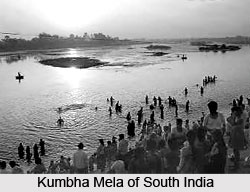 Tirumakudalu refers to the land at the confluence of the rivers Kaveri, Kabini and Spatika Sarovara. This is considered as one of the sacred places in South India. At this place Kumbhamela is held every three years. This place has also been mentioned in the Skanda Purana as one of the Trimakuta Kshetras. `Narasipur` is the name of the town that has been derived from the famous Gunja Narasimhaswamy temple that is located on the right bank of river Kabini.
Tirumakudalu refers to the land at the confluence of the rivers Kaveri, Kabini and Spatika Sarovara. This is considered as one of the sacred places in South India. At this place Kumbhamela is held every three years. This place has also been mentioned in the Skanda Purana as one of the Trimakuta Kshetras. `Narasipur` is the name of the town that has been derived from the famous Gunja Narasimhaswamy temple that is located on the right bank of river Kabini.
It is believed that Tirumakudalu was visualised as `Dakshina Kashi` by sage Agasthya long ago. When he travelled down South to Narsipur, Sage Agasthya was fascinated by the confluence of three rivers. He wanted to install a Shiva Linga there. He asked Hanuman to get one from Kashi. As the fortunate period was fast approaching, Lord Hanuman failed to get the linga on time. Therefore the sage created a sand linga and sanctified it. Hanuman felt insulted and on returning cut off top portion of the sand linga that was blessed by Agastya. From that the Spatika Sarovara is offered as thirtha to the pilgrims. The linga that was blessed by Hanuman is a little distance away and is known as the Hanuman Linga.
Tirumakudalu Narasipura and its surrounding areas are prehistoric sites where several Neolithic sites have been unearthed. This place is rich in mineral and fertile due to which there has been continued human habitation.
This place is known for its temples. The Gunja Narasimha Swamy temple was built during the Vijayanagara period. The image of Narasimha in the sanctum has a weighing balance with a twig with seed of the Gunja tree and therefore it is named so. This temple has inscriptions dating from the Krishnadevaraya period with a blend of Dravidian and Hoysala Architecture as well as records in Nagari script.
There are other temples like the Agasthyeshwara temple that contains many monuments which belong to the Ganga, Chola, Hoysala and Vijayanagara periods. Chariot festivals are conducted every year of Gunja Narasimha Swamy and Agastheswara.






